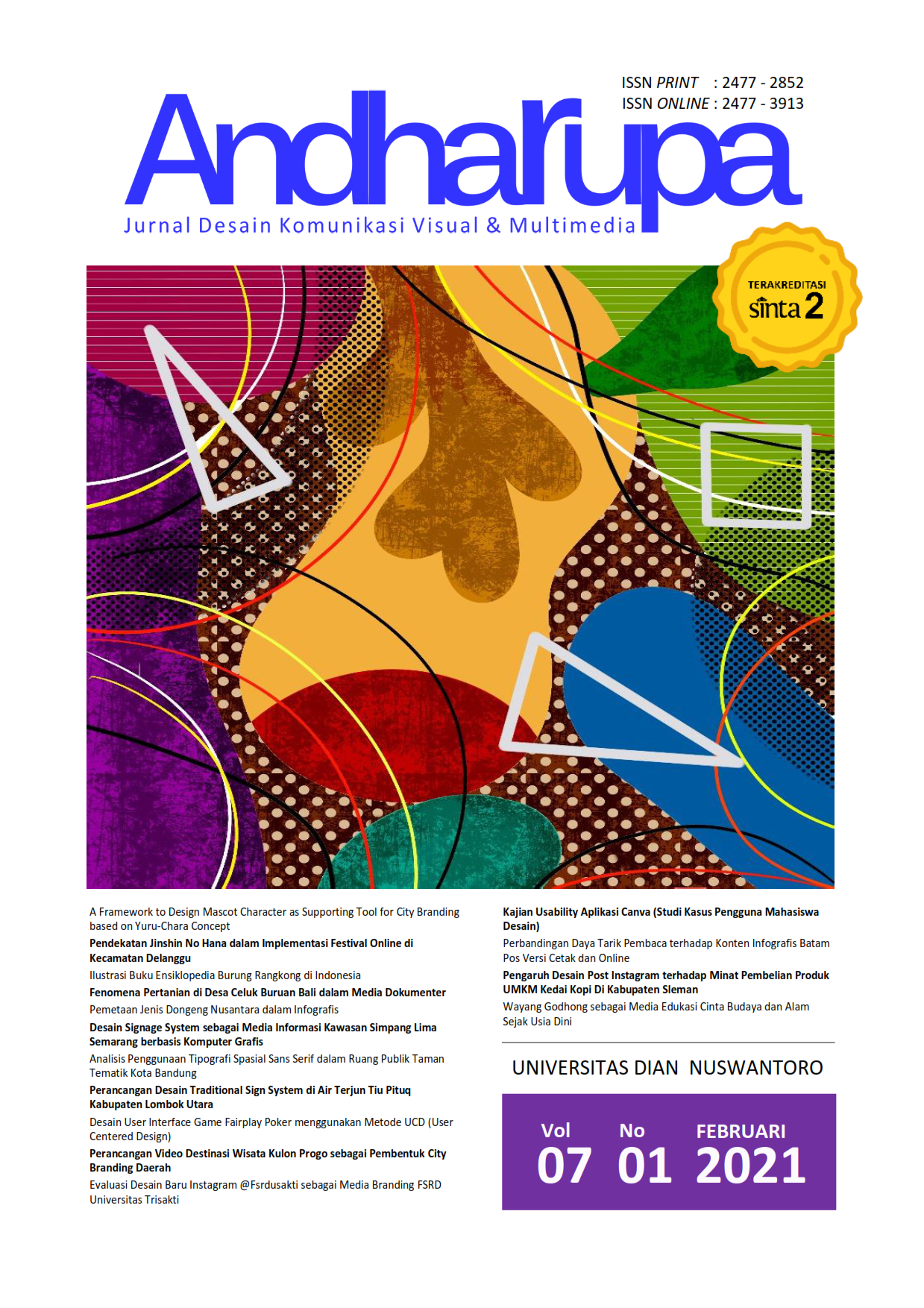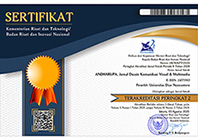DESAIN USER INTERFACE GAME FAIRPLAY POKER MENGGUNAKAN METODE UCD (USER CENTERED DESIGN)
DOI:
https://doi.org/10.33633/andharupa.v7i01.4247Abstract
AbstrakDi Indonesia, salah satu permainan yang menjadi kegemaran adalah bermain game Poker. Poker merupakan permainan kartu aturan yang dapat dimainkan secara langsung maupun lewat internet. Game Poker online adalah salah satu sarana efektif untuk menghabiskan waktu sekaligus hiburan kesenangan bermain poker dengan banyak orang. Salah satu game Poker yang terkenal adalah Zynga Poker. Pencarian data yang ditemukan bahwasannya permainan tersebut mempunyai kekurangan pada bagian user interface yang berat saat digunakan sehingga penulis mencoba untuk membuat user interface game online sejenis menggunakan metode UCD (User-Centered Design) dengan nama game FairPlay Poker. Desain yang dihasilkan adalah desain ilustrasi 2D yang digunakan dengan lebih ringan. Kata kunci: Game, metode UCD, User interface, Poker, AbstractIn Indonesia, one of the favorite online games is poker. Poker is a card game with some rules that can be played directly or via the internet. Online Poker game is one of the effective media to spend time and amuse pleasure by playing poker with peoples. The Infamous Poker game is known as Zynga Poker. From the data search that had been done, the game still has a few weaknesses in the heavy User Interface that the authors try to develop a similar user interface poker game. Which name the Fairplay Poker using UCD (User-Centered Design) methodology. A design resulted in an illustration designed in 2D that can improve loading with lighter. Keywords: Game, UCD Method, User interface, FairplayReferences
Abras, C., Maloney-Krichmar, D. & Preece, J. (2004). User-centered design. Bainbridge, W. Encyclopedia of Human-Computer Interaction., 37(4), pp. 445-456.
Deliusno. (2013). 10 Game Facebook Terpopuler di Indonesia. [Online] url: https://tekno.kompas.com/read/2013/07/16/1148114/10.igamei.facebook.terpopuler.di.indonesia. [Accessed 20 10 2020].
EDITORS, H. (2017). Video Game History. [Online] url: https://www.history.com/topics/inventions/history-of-video-games. [Accessed 27 10 2020].
Lindsay, G. (2005). Game Type and Game Genre. [Online] url: https://www.researchgate.net/publication/262250061_Game_Type_and_Game_Genre [Accessed 19 10 2020].
Mayhew, D. J. (1999). The Usability Engineering Lifecycle: A Practitioner's Handbook for User interface Design (Interactive Technologies). 1st Edition ed. United Stated: Morgan Kaufmann.
Mcleod, R. (1995). Sistem Informasi Management. Jakarta: PT. Prenhalindo.
Olga, R. (2015). Website Redesign: Improving User Experience and User interface on the Havusport Website (Thesis), Finland: University of Applied Science.
Sani, K. (2014). Perceptual Human Computer Interaction / Interface Menggunakan Teknik Computer.
Suteja, B. R. & Harjoko, A. (2008). Perancangan User interface E-Learning Berbasis Web. Yograkarta, UPN ”Veteran” Yogyakarta, pp. 36 - 46
Downloads
Published
Issue
Section
License
Copyright (c) 2021 ANDHARUPA: Jurnal Desain Komunikasi Visual & Multimedia

This work is licensed under a Creative Commons Attribution 4.0 International License.
Authors who publish with this journal agree to the following terms:
- Authors retain copyright and grant the journal right of first publication with the work simultaneously licensed under a Creative Commons Attribution License that allows others to share the work with an acknowledgment of the work's authorship and initial publication in this journal.
- Authors are able to enter into separate, additional contractual arrangements for the non-exclusive distribution of the journal's published version of the work (e.g., post it to an institutional repository or publish it in a book), with an acknowledgment of its initial publication in this journal.
- Authors are permitted and encouraged to post their work online (e.g., in institutional repositories or on their website) prior to and during the submission process, as it can lead to productive exchanges, as well as earlier and greater citation of published work (See The Effect of Open Access).















